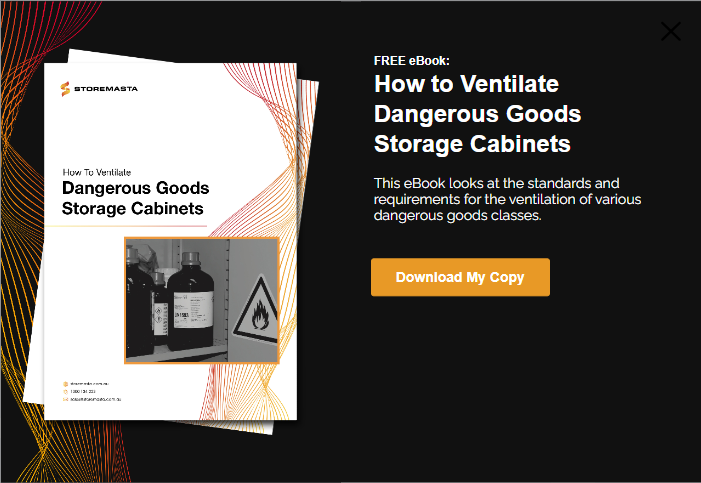Flammable liquids are liquids that give off enough flammable vapours, at temperatures below 60 °C, to ignite in the presence of an ignition source. Flammable vapours that disperse from flammable liquids present a number of risks to the workplace. To protect the people and property of your organisation, it is important to implement controls to reduce the risks associated with flammable vapours.
One method that can be used to control flammable vapours is to install a ventilation system on a flammable storage cabinet. However, a ventilation system is not a mandatory requirement. The Australian Standard that outlines the requirements for the storage and handling of flammable liquids is AS1940-2017 - The storage and handling of flammable and combustible liquids. Section 4.9.5 of this standards outlines the requirements for ventilating flammable liquids storage cabinets.
This section states:
Where ventilation is installed, it shall be designed so that vapours are prevented from escaping into any room. Any ventilation exhaust shall be to the outside atmosphere and in a location which allows the safe dispersal of vapours and is away from any ignition sources (see Clause 4.5).
In the context of the Australian Standards, the word “shall” indicates that a statement is a mandatory requirement. As this standard doesn’t state that a “ventilation system shall be installed” it means that ventilation of flammable liquids storage cabinets is not a mandatory requirement.
If you chose to install a ventilation system on a flammable storage cabinet, there are mandatory requirements in regards to how this ventilation system should be designed and installed. However, there are some situations where ventilation of Class 3 cabinets may be a mandatory requirement.
Situations where ventilation is mandatory
If the flammable liquids that you are storing in your flammable liquids storage cabinet are listed in the workplace exposure standards, a ventilation system may be mandatory.
The workplace exposure standard document that was developed by Safe Work Australia. This standard contains a list of around 700 hazardous substances and their maximum legal airborne concentration in the workplace.
If the flammable liquids stored in your cabinet are listed in the workplace exposure standards and they are producing a concentration of vapours that is above the the maximum legal limit outlined in the workplace exposure standards, you will require a ventilation system to bring the vapours down to a safe concentration.
Situations where ventilation may be required
Even though the flammable liquids that you are storing may not be listed in the workplace exposure standard, there may be instances where a ventilation system would be required for safety purposes even if it’s not a legal requirement.
We'll look at some of these situations in more detail below.
You must consider your workplace environment, as well as the exposure standards, when determining if you require ventilation for your flammable cabinet.
Ignition sources
If there are a lot of ignition sources such as powerpoints, sparks and hot surfaces in the workplace where your flammable liquids are present, it would be a good practice to ventilate your flammable liquids storage cabinets. If flammable vapours come into contact with an ignition source, a fire will erupt and harm the people and property in your workplace.
The Australian Standard does state that flammable cabinets should be isolated from ignition sources by at least 3 meters, however flammable vapours have the ability to spread long distances and come into contact with ignition sources.
Therefore if there are a lot of ignition sources in your workplace, it would be safe practice to install a ventilation system on your Class 3 storage cabinets.
Incompatible chemicals
Another situation where you may require a ventilation system, is when your flammable liquids storage cabinets are located next to other incompatible classes of dangerous goods. If the vapours of incompatible substances mix, there is a possibility that they will react dangerously and harm the people and property of your organisation.T
Substances that are incompatible with flammable liquids include:
If any of these substances are stored in close proximity to your flammable liquids storage cabinet, it would be a good practice to ventilate your flammable cabinet to an outdoor location to avoid incompatible vapours mixing and causing violent chemical reactions.
Like to learn more about Dangerous Goods storage?
Working areas
If the flammable liquids in your workplace are stored in an area where people work or congregate, your flammable liquids storage cabinets may require a ventilation system. Flammable vapours are toxic and they have the potential to cause harm to human health. If large quantities of flammable vapours are inhaled, they can cause;
- Intoxication
- Asphyxiation
- Headaches
- Nausea
- Vomiting
To avoid these severe health effects, it would be safer to ventilate your cabinets. A ventilation system would decrease the concentration of flammable vapours to a level safe for your people to work in.
Ventilating Flammable Cabinets
As flammable vapours can have adverse effects upon the people and property of your organisation, it is a good practice of ventilate flammable liquids storage cabinets. The Australian Standard AS1940 doesn’t make ventilation of flammable cabinets a mandatory requirement, however if the flammable liquids that you are storing are listed in the workplace exposure standards, a ventilation system will be required.
If you would like more information on how to ventilate dangerous goods storage cabinets, download our FREE eBook by clicking on the image below.
Joining the team as a Dangerous Goods Storage Consultant, Melissa Hampton became Storemasta's Marketing Manager in late 2021. With extensive knowledge and experience in chemical compliance, Melissa is responsible for leading the Marketing team and helping shape their marketing strategy. In her spare time, you can find Melissa hiking, swimming and enjoying the great outdoors in beautiful north-west Tasmania.

